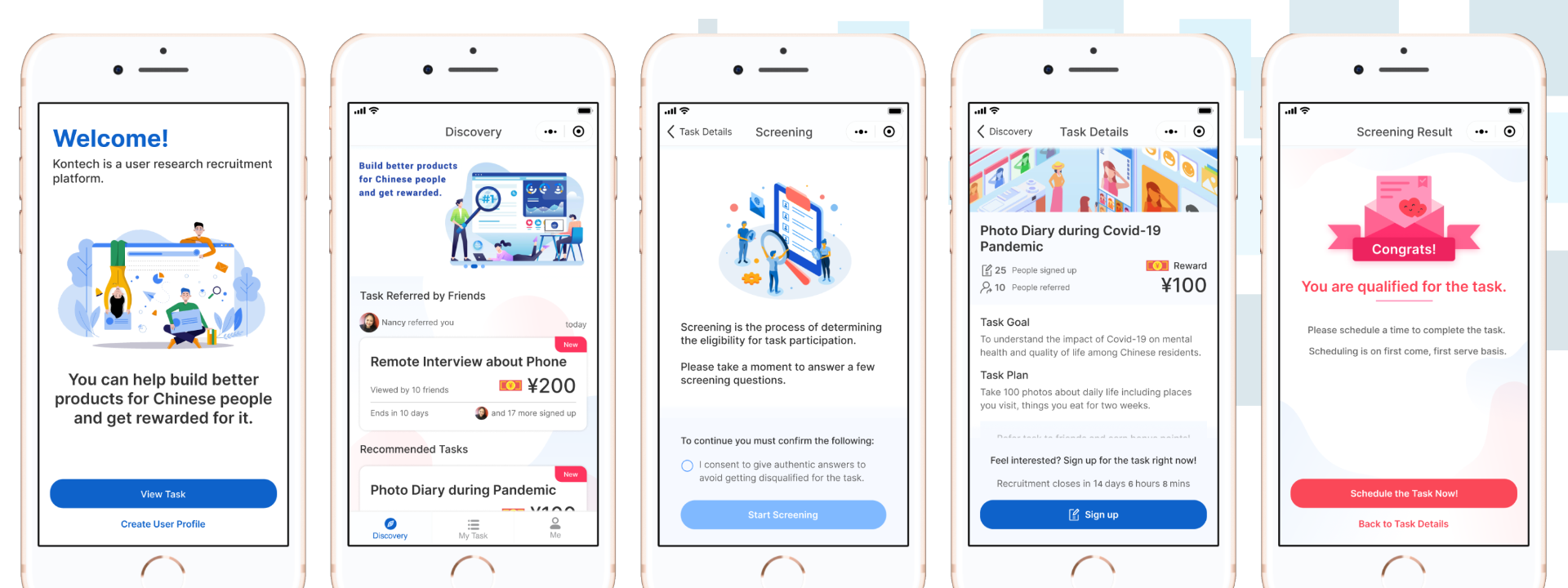
Kontech Platform
MAY 2020-AUG 2020
In the third term of Master of Digital Media program, I collaborated with Kaizor Innovation, a strategic consultancy client to come up with a solution to streamline their process of recruiting participants for user research in China.
Key Achievements and Responsibilities
Contribute as the Lead UX Designer researching competitive landscape, mapping user journey, building information architecture, creating UI mockups, and conducting usability testings.
Support project management and collaboration as the Scrum Master leveraging agile methodologies to plan and execute Sprints ensuring milestones were achieved.
In thirteen weeks, the team delivered a functional prototype of a user research recruitment platform based on WeChat mini-program.
The Unique Challenge
Chinese culture places a high value on networks of personal relationships and Chinese people tend to be less trusting of people they are not familiar with. This skepticism extends to marketers who want to collect personal information for user research. As a result, recruiting users in China is currently a pain point for Kaizor. They are looking for a way to streamline or even automate this process.
Our project’s goal was to gain the trust of Chinese audience in the recruitment process so that Kaizor can recruit the right users efficiently. To achieve this goal, we aimed to solve two problems:
How to build trust with Chinese users
How to motivate the target audience to respond to recruitment and participate in user research
Research Findings
By conducting interviews with Chinese users, we confirmed that Chinese people placed their trust in established relationships with friends, colleagues and family members. In addition, we learned that some will participate in user research without a reward if they are interested in the topic. For those who need more tangible incentives, cash is the best gift.
Given that Chinese society places the most trust in personal relationships, our solution was to build trust by leveraging users’ existing networks of connections through WeChat, the most popular social media app in China.
Solution:
Relationships Network
On this platform, the connection between user research tasks and WeChat friends is visible, which makes the information presented seem more trustworthy.
Solution:
Incentive System
We use an incentive system to encourage users to refer tasks to their WeChat contacts. The referrer will then receive reward points when their friend completes the task. These points can be redeemed for cash via WeChat Wallet.
User Journey Mapping
I mapped out the user journey of the entire process of recruitment on the platform and identify several key user stories including:
Discover research recruitment information by active searching or referral
Onboard the platform
View and sign up for research task
Pass screening and schedule time
Receive confirmation and reminder
Complete research task and get cash reward
Referral Mechanics
The design team designed a referral mechanics specifying interactions between task referrer and referee, and the incentive economy in the referral process.
A unique feature called Send Appreciation following the task completion phase allows the referrer to recognize who has participated in the referred research. Appreciation sender and receiver both get additional reward points which can help build and strengthen a reciprocal relationship between users.
Information Architecture
I built two versions of information architecture for Kontech platform.
The ideal version includes a social community which allows users to share stories of research participation experience by posting reviews and photos. Such community feature leverages evidence and consensus to reinforce the credibility of the platform and creates a sense of belonging for the user.
After a technical review, the team decided to narrow the information architecture down to a MVP version which focused on the key user stories mapped out in the user journey.
Development
Process
During the ideation phrase, the team adopted practices from Design Sprint to generate project goals, research topics and solution ideas. We followed the Scrum Methodology to conduct design and development process once green light was obtained from the client.
The UI mockups were created in Figma and iterated from low-fidelity to high-fidelity versions. In between each iteration, we conducted usability testing to refine the design based on user feedback.
After four rounds of iteration, the finalized design prototype was delivered to the development team and built as a functional prototype using WeChat mini-program SDK.
Conclusions and Takeaways
We are proud to deliver a functional prototype of our WeChat mini-program. During user testing and interview sessions, participants gave positive comments and showed great interest in further engagement with the product when it is launched.
As a team, we overcame the challenges of remote collaboration in this unique time to achieve our goals. We collaborated closely with our clients and conducted testing remotely with our target audience of Chinese users to validate our solutions.
Our client was very impressed by the prototypes we delivered and decided to continue implementing the platform fully.











